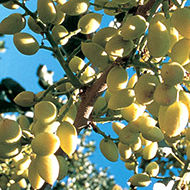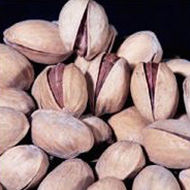Unique Chemistry Helps Combat Late Blight in Pistachios
October 26, 2017

Pistachios occupy one of the highest acreages for tree nuts produced in the United States, and production is on the rise.
In the past few decades, the pistachio sector in California has seen steady expansion. Pistachios have been promoted as a healthy and convenient snack, reinforcing consumption habits across the United States and worldwide. In response to increased consumer demand for pistachios, growers have increased production.
California plays the principal role in the nation’s pistachio sector, producing roughly 98 percent of the country’s pistachios. However, the pistachio crop in California has a high level of genetic uniformity, making them vulnerable to disease threats and resistance issues.
Late Blight: A Threat to California Pistachios

Late blight poses one of the most severe threats to pistachios. Damage to orchards from Alternaria late blight stems from any of three different species of the disease, often causing early defoliation of trees and nutshell staining.
In recent years, the disease has become more difficult to manage, as fungicide resistance issues have been reported. Themis Michailides, a researcher at the University of California, Davis, has been conducting research on pistachios for more than 25 years and was one of the first to identify the growing pistachio fungicide resistance issue for Alternaria late blight. Through his research, Michailides has reported a decrease in efficacy for strobilurin fungicides and mixtures of carboxamide with strobilurin fungicides.
“Alternaria blight has been so severe and difficult to control that fungicide resistance issues are a major concern,” said Michailides. “In checking Alternaria isolates for resistance, we found that most of the isolates that were resistant to boscalid chemistries were cross-resistant to penthiopyrad chemistries.”
Enter Luna® Fungicide: A Unique, Effective Chemistry

As different chemistries are introduced into the market, hope remains for a resolution to current resistance problems, researchers said. For example, fluopyram, the active ingredient in Luna fungicide from Bayer (including Luna Experience® and Luna Sensation®), offers growers an alternative chemistry to combat Alternaria concerns. Although fluopyram shares the same mode of action as the carboxamide chemistries, it differs significantly in shape and molecular flexibility from those of other fungicides. The difference has allowed fluopyram to maintain control of certain carboxamide-resistant mutants.
“Fluopyram has a different structure than boscalid and penthiopyrad, offering a new chemistry for growers to use in managing Alternaria,” said Michailides. “In our experiments, Luna performed exceptionally well – and in some cases a little better – than the other fungicides in controlling Alternaria.”
Luna's Efficacy Against Multiple Diseases
Along with its effective performance in Alternaria efficacy trials, Michailides said he is also hopeful for Luna’s impact on preventing Botryosphaeria and Botrytis infections in pistachios. Through laboratory trials, Michailides found that Botrytis was highly sensitive to the product, and that use of Luna resulted in no infections and complete prevention of the disease.
“Our research points to Luna as an excellent material for all the major diseases of pistachio in California,” said Michailides. “Based on our resistance studies, I would definitely expect for its efficacy to last longer than other analogous fungicide mixtures.”
California’s pistachio production plays a critical role in the nation’s tree nut sector. As damaging diseases become increasingly resistant to certain pistachio fungicides containing carboxamide chemistries, crop protection experts say it is critical for pistachio growers to utilize products suited for resistance management by alternating fungicide chemistries.